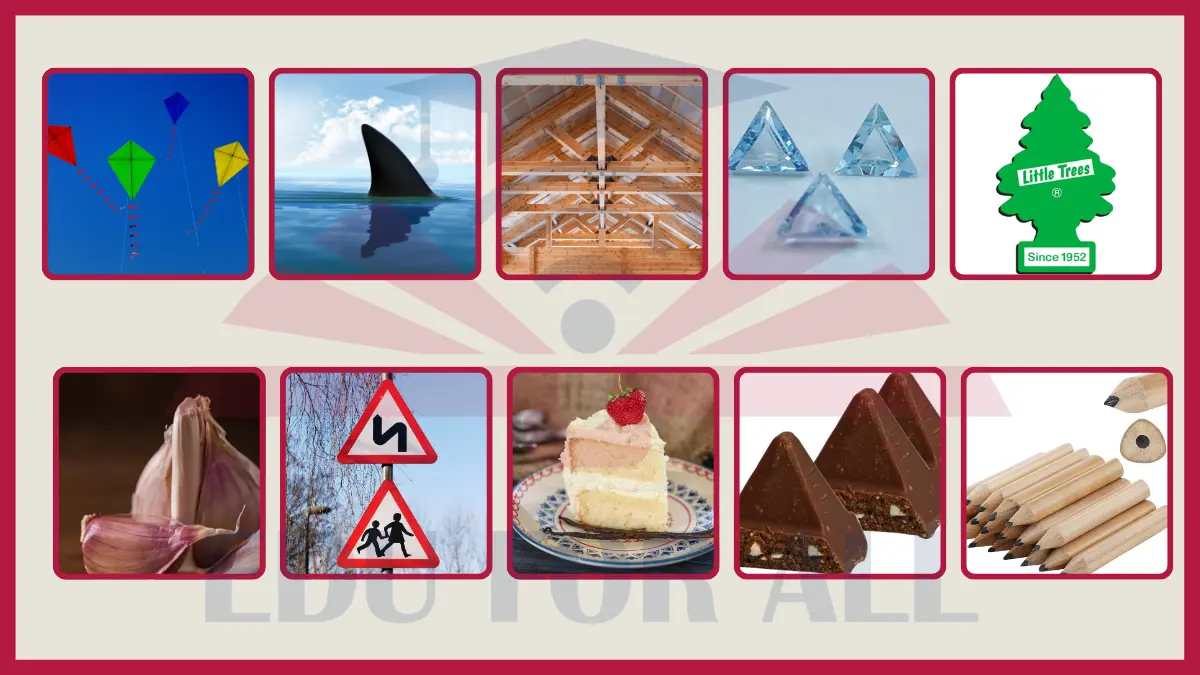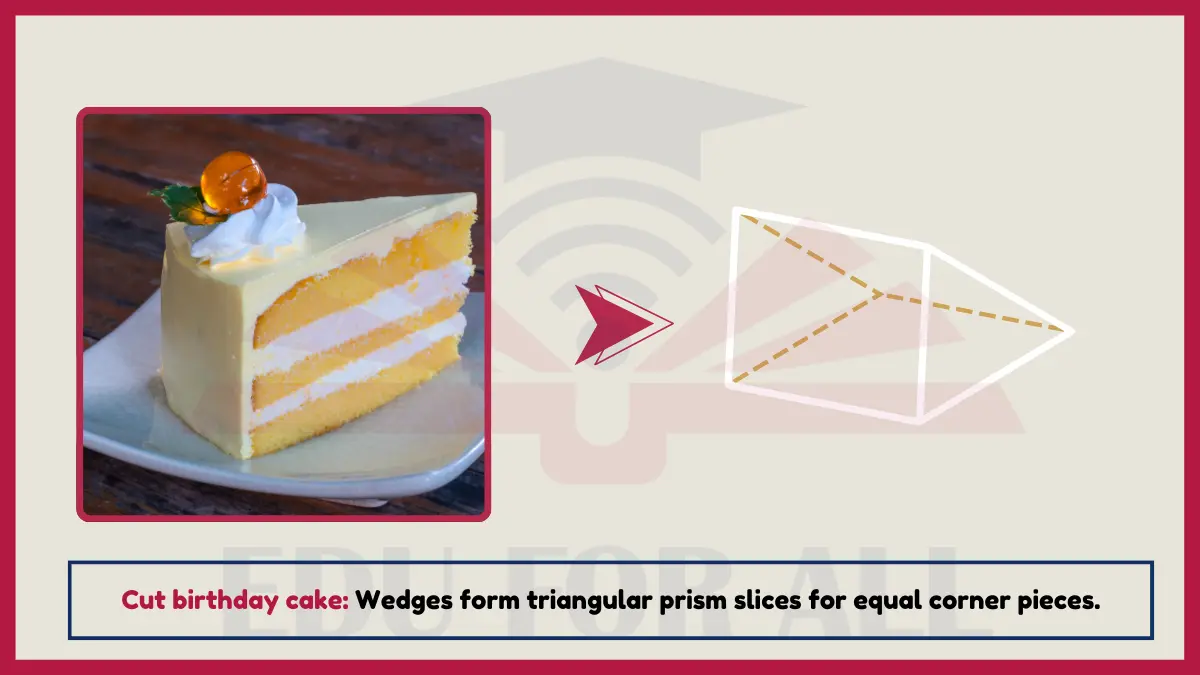There are many examples of triangular prisms we come across regularly in common objects around us. For example, the classic shape of a pencil is a triangular prism, its long, slim body is made of wood shaped into a three-sided form. Pieces of chocolate broken off a Toblerone bar also display triangular prisms, which come from imprinting its unique mold.
Other everyday examples of Triangular Prism include triangular road signs that are highly visible to drivers, separation of garlic into tiny three-sided pyramids, and of course, slices of cake or pizza cut into those familiar triangular wedges we grab eagerly.

Examples of Triangular Prism
Here are some most common Examples of Triangular Prism:
1. Three-sided Pencil
A standard wooden pencil has a triangular prism shape. Its long, narrow body has 3 flat sides meeting at sharp corners.The sharper corners mean graphite points will need shaping more often.
Do You Know?
The triangle design minimizes how often the pencil rolls off desks and tables.

Experiment: Roll several pencils on a flat table. Notice how the triangular shape makes them roll unevenly compared to objects with circular or square cross-sections. They move jerkily and settle into a corner of the table.
2. Pieces of Toblerone chocolate
The iconic Swiss Toblerone chocolate bar contains distinct triangular prism shaped chunks. The unique shape comes from imprinting a triangular mold onto the chocolate.
Do You Know?
The triangles resemble the snowcovered alpine mountain peaks near where Toblerone originated. The Mattehorn peak also inspired Toblerone’s logo image.

Experiment: Melt some chocolate and pour it into triangle shaped molds. Observe how it hardens into triangular prisms.
3. Roof trusses
Many roofs have rigid triangular truss frameworks underneath to provide crucial structural support. Triangle shapes lend exceptional strength and stability.
Do You Know?
Steel beams are also increasingly being molded into elongated triangular shapes for the same reasons.

Experiment: Make sample truss bridges out of toothpicks and notice how triangle patterns make them rigid. The bonds between vertices prevent wobbling or flexing.
4. Cut gemstones
Jewels like diamonds or rubies are often precision cut into triangular prisms to make them sparkle extra brightly. Light refracts internally off the special angled faces.
Do You Know?
The first 58-faceted brilliant cut diamond was designed this way in 1919, transforming raw gems into dazzling jewels.

Experiment: Shine a flashlight through a Cut gemstone and observe how the light splits into a rainbow. The precise angles determine how perfectly white light separates into distinct colors.
Also Read: Exmaples of Angles
5. Road signs
Traffic warning signs often use a thick triangular prism form to stand out clearly to passing drivers. The wide, triangular base provides maximum stability against wind and weather.
Do You Know?
Regulations strictly govern road sign shape and dimensions to optimize visibility and standardization.

Experiment: Test the stability of road sign mockups in windy conditions when shaped as squares vs triangles. The triangular ones should resist toppling over much better.
6. Cut birthday cake
Sheet birthday cakes are commonly sliced into triangular wedges for easy serving. The wedge shape ensures everyone gets an icing-coated corner piece.
Do You Know?
Some claim mathematician Pythagoras invented the wedge cake cut to celebrate geometrical progress with his students.

Experiment: Cut a cake or brownie into wedges rather than squares. Compare how much crust people get with each slice. Wedges guarantee crunchy corners in every portion.
7. Garlic cloves
The individual segments of a garlic bulb separate into small triangular prisms. Their tapered tips help push up through the soil as they grow.
Do You Know?
Digging up wild garlic reveals an underground system of stringy triangular roots spreading to sprout more growth.

Experiment: Try planting garlic cloves pointy-side up vs sideways to observe which grows more easily upward. The orientation should make the shoots emerge more readily.
8. Pool shark fins
The dorsal fins on some pool sharks protrude in roughly triangular shapes. The hydrodynamic form may aid fast swimming motions.
Do You Know?
Many such sharks can swim up to 40 mph assisted by these specialized fins evolved over millions of years.

Experiment: Test model shark fins with square vs triangular shapes to see which design cuts most smoothly through water in simulated swimming motions. The triangle should have noticeably less drag.
9. Pine tree air fresheners
Car air fresheners infused with pine tree scent often have a triangular prism form that clips onto vents. The design maximizes flow of fragrance into circulating air.
Do You Know?
Research shows the iconic pine tree shape triggers consumers to psychologically associate the product with freshness and cleanliness.

Experiment: Hang experimental paper flower, square, and triangular shapes near a fan blowing lightly. See which flutters enough to release scent quickest. The stiffness of the triangle should make it waiver productively.
10. Kite frames
Simple kite designs frequently use triangular skeletons rather than squares for increased strength, wind resistance, and flight performance.
Do You Know?
Alexander Graham Bell used tetrahedron kites, a type of intricate triangular framing, to lift humans briefly while exploring early aviation.

Experiment: Construct sample kites using square versus triangular balsa wood frames. Evaluate their relative durability and flying height under windy outdoor conditions. The triangular form should clearly prevail.

